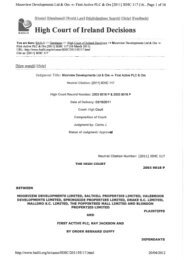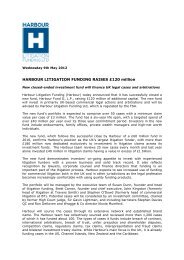Lord Justice Jackson - Harbour Litigation Funding
Lord Justice Jackson - Harbour Litigation Funding
Lord Justice Jackson - Harbour Litigation Funding
Create successful ePaper yourself
Turn your PDF publications into a flip-book with our unique Google optimized e-Paper software.
THIRD PARTY FUNDING OR LITIGATION FUNDING (tpflflecture5)<br />
SIXTH LECTURE BY LORD JUSTICE JACKSON IN THE CIVIL<br />
LITIGATION COSTS REVIEW IMPLEMENTATION PROGRAMME<br />
DELIVERED AT THE ROYAL COURTS OF JUSTICE ON 23 rd NOVEMBER<br />
2011<br />
“The human species, according to the best theory I can form of it, is composed of two distinct races,<br />
the men who borrow, and the men who lend.” 1<br />
1. INTRODUCTION<br />
1.1 I am delighted to attend this gathering of litigation funders and others, to mark the<br />
launch of the new Code of Conduct. Under Lamb’s classification, litigation funders<br />
would very roughly fall into the second category of humanity. 2 In order not to disrupt<br />
such a jovial occasion, I shall hand down this lecture in writing for those who wish to<br />
read it over their glass of wine, and confine my oral presentation to a brief synopsis of<br />
the lecture.<br />
1.2 This lecture. This is the fifth lecture in the present series. The previous four<br />
lectures can all be accessed on the Judiciary website. 3 This lecture, like the previous<br />
ones, has paragraph numbers for ease of cross-reference.<br />
1.3 Terminology. The title of this lecture is somewhat longwinded, because the<br />
nomenclature has recently changed. What used to be called “third party funding” is<br />
now more commonly called “litigation funding”. I shall use the latter term in this<br />
lecture, although “third party funding” was the term used in my two reports. I shall<br />
refer to the Civil <strong>Litigation</strong> Costs Review as “the Costs Review”. I shall refer to the<br />
Costs Review Preliminary Report as “the Preliminary Report” and the Costs Review<br />
Final Report as “the Final Report”. I shall use the abbreviation “CFA” for conditional<br />
fee agreement.<br />
2. BACKGROUND<br />
2.1 A late arrival. The funding of claims by commercial bodies in return for a share<br />
of the proceeds has been a late arrival on the litigation scene. This is because outside<br />
interference of this nature was long regarded as morally reprehensible (since it stirred<br />
up litigation) and unlawful (because of the doctrines of maintenance and champerty).<br />
2.2 Narrowing of maintenance and champerty. Maintenance and champerty remain as<br />
torts. 4 However, their scope has been progressively narrowed by judicial decisions:<br />
1 Charles Lamb, The Two Races of Men, Essays of Elia, 1823<br />
2 Hopefully the clients are an improvement on Lamb’s first category: “What a careless, even<br />
deportment hath your borrower! What rosy gills! What a beautiful reliance on Providence doth he<br />
manifest, taking no more thought than lilies! What contempt for money …”<br />
3 www.judiciary.gov.uk<br />
4 But not as crimes: see s. 14 (1) of the Criminal Law Act 1967<br />
1
see, for example, the recent decision of the Court of Appeal in Sibthorpe v Southwark<br />
Borough Council [2011] EWCA Civ 25, [2011] 1 WLR 2111.<br />
2.3 Properly structured litigation funding approved. It is now established that<br />
properly structured litigation funding does not infringe the rules against maintenance<br />
and champerty: see Arkin v Borchard Lines [2005] EWCA Civ 655, [2005] 1 WLR<br />
3055. In describing a funding agreement which does not infringe, the court said this<br />
at [40]:<br />
“Our approach is designed to cater for the commercial funder who is financing part of the costs of the<br />
litigation in a manner which facilitates access to justice and which is not otherwise objectionable. Such<br />
funding will leave the claimant as the party primarily interested in the result of the litigation and the<br />
party in control of the conduct of the litigation.”<br />
2.4 Developments between 2005 and 2009. The Court of Appeal’s decision in Arkin<br />
brought litigation funding into the main stream in England. The High Court’s<br />
majority decision in Campbell’s Cash & Carry Pty Ltd v Fostif Pty Ltd [2006] HCA<br />
41 had a similar effect in Australia. 5 The Civil <strong>Justice</strong> Council (“CJC”) took up the<br />
baton. In 2005 the CJC published its report “ Improved Access to <strong>Justice</strong> – <strong>Funding</strong><br />
Options and Proportionate Costs “ (authors M Napier, Judge P Hurst, R Musgrove,<br />
Prof Peysner). This proposed that “building on the judgment of the Court of Appeal<br />
in Arkin further consideration should be given to the use of third party funding as a<br />
last resort means of providing access to justice “. After debating these matters in a<br />
forum the CJC published a further report in 2007 entitled “ Improved Access to<br />
<strong>Justice</strong> – <strong>Funding</strong> Options and Proportionate Costs “ (authors M.Napier, Judge P<br />
Hurst, Prof Moorhead, R Musgrove, C Stutt). Recommendation 3 of that Report said:<br />
“Properly regulated Third Party <strong>Funding</strong> should be recognised as an acceptable option for<br />
mainstream litigation.Rules of Court should also be developed to ensure effective controls over<br />
the conduct of litigation where third parties provide the funding.”<br />
Following further forum discussions the CJC prepared a first draft voluntary code of<br />
conduct for “Third Party <strong>Litigation</strong> <strong>Funding</strong>”. This draft code did not enter the public<br />
domain for a year. So its provisions could not be discussed in my Preliminary Report,<br />
although they could be and were discussed in the Final Report<br />
2.5 Costs Review. The question of third party funding (as it was then still called) was<br />
one of the discrete issues considered during the Costs Review: see chapter 15 of the<br />
Preliminary Report and chapter 11 of the Final Report. My three recommendations in<br />
respect of third party funding were as follows: 6<br />
“11. A satisfactory voluntary code, to which all litigation funders subscribe, should<br />
be drawn up. This code should contain effective capital adequacy<br />
requirements and should place appropriate restrictions upon funders’ ability<br />
to withdraw support for ongoing litigation.<br />
12. The question whether there should be statutory regulation of third party<br />
funders by the FSA ought to be re-visited if and when the third party funding<br />
5 For a discussion of the extensive use of litigation funding in Australia, see Preliminary Report,<br />
chapter 58 (Australia) para 4.6. At the time of my visit to IMF in Sydney, that company had supported<br />
approximately 200 cases, paying out adverse costs in those few cases which its clients had lost.<br />
6 Using the numbering in the list of recommendations at the end of the report, pages 463-467<br />
2
market expands.<br />
13. Third party funders should potentially be liable for the full amount of adverse<br />
costs, subject to the discretion of the judge.”<br />
2.6 Developments in 2010. These issues were considered at a number of events during<br />
2010, including a litigation funding conference at Oxford University and a CJC<br />
stakeholder forum. At that forum a nascent <strong>Litigation</strong> Funders Association was formed<br />
and the CJC agreed to oversee the development of a suitable code of conduct for<br />
litigation funding. Between July and December the CJC conducted a consultation<br />
exercise on a draft code and draft articles for the <strong>Litigation</strong> Funders Association.<br />
2.7 Preparation of the Code of Conduct in its final form. In early 2011 Michael Napier<br />
QC was appointed chairman of a CJC working party which was to develop the Code of<br />
Conduct in consultation with all interested parties. I pay tribute to Mike for the<br />
excellent and painstaking work which he has done in bringing this project to fruition.<br />
The finished product which you all have before you today has gone through<br />
innumerable drafts and it meets, so far as any draftsman reasonably can, the concerns<br />
which have been raised by the various stakeholder groups. The working party was kind<br />
enough to consult me from time to time and to invite me to speak at their seminar in<br />
May 2011.<br />
2.8 The final product delivered by the working group comprises:<br />
Code of Conduct for <strong>Litigation</strong> Funders (“the Code”)<br />
Rules of the Association for the Association of UK <strong>Litigation</strong> Funders (“the Rules”).<br />
2.9 Link between the Code and the Rules. Rule 6.1 of the Rules requires every member<br />
of the Association of UK <strong>Litigation</strong> Funders to abide by the Code, to the extent that it<br />
applies to them.<br />
3. THE CODE OF CONDUCT IN ITS FINAL FORM<br />
3.1 A clear and straightforward document. Both the Code and the Rules are clear and<br />
straightforward documents, which belie the huge amount of effort and negotiation that<br />
have gone into their drafting. The Rules require all members of the Association to<br />
abide by the Code. The Code sets out the obligations of funders in a short and clear<br />
document. The litigation funding agreement between funder and client is referred to as<br />
“LFA”. I attach the final version of the Code as an appendix.<br />
3.2 My original concerns. My particular concerns originally were as follows:<br />
(i) That there should be proper provision for capital adequacy. (The provision in the<br />
original draft code that the funder should be able to meet its liabilities for the next three<br />
months was plainly inadequate.)<br />
(ii) That the funder should not be entitled to terminate the funding agreement midlitigation<br />
without good reason. (The original draft code appeared to permit this.)<br />
(iii) That the extent of the funder’s ability to influence the litigation and any settlement<br />
negotiations should (a) be properly restricted and (b) defined with clarity.<br />
3
See chapter 11 of the Final Report.<br />
3.3 Those concerns have been met. Nothing is certain in this sublunary world and no<br />
contract is totally watertight. However, in my view the final version of the Code meets<br />
each of those concerns to a reasonable extent.<br />
Capital adequacy<br />
3.4 Clause 7. Capital adequacy is addressed in clause 7 of the Code, which provides:<br />
“A funder will:<br />
“(d) maintain at all times adequate financial resources to meet its obligations to<br />
fund all of the disputes that it has agreed to fund, and in particular will maintain the<br />
capacity:<br />
(i) to pay all debts when they become due and payable; and<br />
(ii) to cover aggregate funding liabilities under all of its LFAs for a minimum<br />
period of 36 months.”<br />
3.5 Comment. This is a very substantial improvement upon the original provision. 7<br />
Obviously there are cases which will run for more than three years, although such cases<br />
are becoming rarer and I hope that other pending reforms will further reduce their<br />
number. Nevertheless, as a provision in a code to which funders are expected to sign up<br />
voluntarily, in my view this clause strikes a reasonable balance between practicality and<br />
client protection.<br />
Withdrawal<br />
3.6 Clauses 9 and 10. Clauses 9 and 10 of the Code provide:<br />
“9. The LFA shall state whether (and if so how) the Funder may:<br />
…<br />
(b) terminate the LFA in the event that the Funder:<br />
(i) reasonably ceases to be satisfied about the merits of the dispute;<br />
(ii) reasonably believes that the dispute is no longer commercially viable; or<br />
(iii) reasonably believes that there has been a material breach of the LFA by the<br />
Litigant.<br />
10. The LFA shall not establish a discretionary right for a Funder to terminate a<br />
LFA in the absence of the circumstances described in clause 9(b).”<br />
3.7 Comment. Again these provisions are a very substantial improvement upon the<br />
original draft 8 and they achieve a fair balance between the interests of funder and client.<br />
7 See Final Report, chapter 11, para 2.9.<br />
8 See Final Report, chapter 11, para 2.7.<br />
4
There is also to be a QC clause in every LFA to deal with disputes between funder and<br />
client.<br />
Control<br />
3.8 Clause 7. Clause 7 of the Code provides:<br />
“7. A Funder will:<br />
(a) take reasonable steps to ensure that the Litigant shall have received<br />
independent advice on the terms of the LFA, which obligation shall be satisfied if the<br />
Litigant confirms in writing to the Funder that the Litigant has taken advice from the<br />
solicitor instructed in the dispute;<br />
(b) not take any steps that cause or are likely to cause the Litigant’s solicitor or<br />
barrister to act in breach of their professional duties;<br />
(c) not seek to influence the Litigant’s solicitor to cede control or conduct of the<br />
dispute to the Funder; …”<br />
3.9 Comment. This provision should prevent the Funder from usurping control of the<br />
litigation in a manner which would infringe the principles referred to in Arkin. On the<br />
other hand the funder has a stake in the litigation. It is or should be entitled to be<br />
consulted. In addition funders build up substantial experience in the fields of litigation<br />
in which they operate. Therefore their views may on occasions be a positive asset for<br />
the client and its legal team.<br />
4. GENERAL<br />
4.1 Importance of the Code. The publication of the Code is an important event. I<br />
anticipate that solicitors will be advising their clients only to enter funding agreements<br />
with litigation funders who sign up to the Code and comply with its provisions.<br />
4.2 The new landscape. There will be a new litigation landscape after 2012, if Part 2 of<br />
the Legal Aid, Sentencing and Punishment of Offenders Bill is enacted in its present<br />
form. There is likely to be a greater role for litigation funders, if CFA success fees<br />
cease to be recoverable. This suggestion is borne out by the experience of Australia,<br />
where success fees have never been recoverable: see chapter 58 of the Preliminary<br />
Report at paras 2.7, 2.8, 4.2 and 4.6. For an up to date review of litigation funding in<br />
Australia, see Michael Legg’s recent article in Civil <strong>Justice</strong> Quarterly. 9<br />
4.3 A wider range of claims? I express the hope that in the future litigation funders will<br />
be able to support a wider range of litigation than at present, including group actions<br />
and claims of lower value.<br />
9 Reconciling <strong>Litigation</strong> <strong>Funding</strong> and the Opt Out Group Definition in Federal Court of Australia<br />
Class Actions (2011) CJQ 52, in particular section 2.2<br />
5
4.4 The range of funding options. The use of commercial litigation funders is just one<br />
means of financing litigation. Other means which will become available when (and if)<br />
the Final Report is implemented are contingency fees, 10 a Supplementary Legal Aid<br />
Scheme 11 and hopefully a Contingent Legal Aid Fund, 12 as well of course as CFAs<br />
without recoverable success fees.<br />
4.5 Conclusion. Today’s publication of the Code will mark the satisfactory<br />
implementation of recommendation 11 in the Final Report, provided that all reputable<br />
litigation funders are willing to join the Association of <strong>Litigation</strong> Funders and sign up to<br />
the Code. My understanding is that they are so willing. The Association will promote<br />
the public interest by enabling properly viable claims to be pursued, including no doubt<br />
some claims which ultimately are unsuccessful. I wish the Association well.<br />
Rupert <strong>Jackson</strong> 23 rd November 2011<br />
10 See clause 42 of the Bill. Contingency fees will be the subject of a later lecture in this series.<br />
11 To which the government is now committed: see the MoJ’s response to the legal aid consultation<br />
published on 21 st June 2011.<br />
12 The Bar Council’s CLAF Group is now actively pursuing this option. See the second lecture in this<br />
series: http://www.judiciary.gov.uk/media/speeches/2011/lj-jackson-speech-contingencylegal-aid-fund.<br />
6
APPENDIX<br />
CODE OF CONDUCT for LITIGATION FUNDERS<br />
1. This code (the Code) sets out standards of practice and behaviour to be observed by Funders<br />
who are Members of The Association of <strong>Litigation</strong> Funders (The Association).<br />
2. A Funder has access to funds immediately within its control or acts as the exclusive investment<br />
advisor to an investment fund which has access to funds immediately within its control, such<br />
funds being invested pursuant to a <strong>Litigation</strong> <strong>Funding</strong> Agreement (LFA) to enable a Litigant to<br />
meet the costs of resolving disputes by litigation or arbitration (including pre-action costs) in<br />
return for the Funder:<br />
(a) receiving a share of the proceeds if the dispute is successful (as defined in the LFA);<br />
and<br />
(b) not seeking any payment from the Litigant in excess of the amount of the<br />
proceeds of the dispute that is being funded, unless the Litigant is in material<br />
breach of the provisions of the LFA.<br />
3. A Funder shall be deemed to have adopted the Code in respect of funding the resolution of<br />
disputes within England and Wales.<br />
4. The promotional literature of a Funder must be clear and not misleading.<br />
5. A Funder will observe the confidentiality of all information and documentation relating to the<br />
dispute to the extent that the law permits, and subject to the terms of any Confidentiality or<br />
Non-Disclosure Agreement agreed between the Funder and the Litigant.<br />
6. A <strong>Litigation</strong> <strong>Funding</strong> Agreement is a contractually binding agreement entered into between a<br />
Funder and a Litigant relating to the resolution of disputes within England and Wales.<br />
7. A Funder will:<br />
(a) take reasonable steps to ensure that the Litigant shall have received independent<br />
advice on the terms of the LFA, which obligation shall be satisfied if the Litigant<br />
confirms in writing to the Funder that the Litigant has taken advice from the solicitor<br />
instructed in the dispute;<br />
7
(b) not take any steps that cause or are likely to cause the Litigant’s solicitor or barrister<br />
to act in breach of their professional duties;<br />
(c) not seek to influence the Litigant’s solicitor to cede control or conduct of the dispute to<br />
the Funder;<br />
(d) maintain at all times adequate financial resources to meet its obligations to fund all of<br />
the disputes that it has agreed to fund, and in particular will maintain the capacity:<br />
(i). to pay all debts when they become due and payable; and<br />
(ii). to cover aggregate funding liabilities under all of it’s LFAs for a minimum<br />
period of 36 months.<br />
8. The LFA shall state whether (and if so to what extent) the Funder is liable to the Litigant to:<br />
(a) meet any liability for adverse costs;<br />
(b) pay any premium (including insurance premium tax) to obtain costs insurance;<br />
(c) provide security for costs;<br />
(d) meet any other financial liability.<br />
9. The LFA shall state whether (and if so how) the Funder may:<br />
(a) provide input to the Litigant’s decisions in relation to settlements;<br />
(b) terminate the LFA in the event that the Funder:<br />
(i). reasonably ceases to be satisfied about the merits of the dispute;<br />
(ii). reasonably believes that the dispute is no longer commercially viable; or<br />
(iii). reasonably believes that there has been a material breach of the LFA by the<br />
Litigant.<br />
10. The LFA shall not establish a discretionary right for a Funder to terminate a LFA in the absence<br />
of the circumstances described in clause 9(b).<br />
8
11. If the LFA does give the Funder any of the rights described in clause 9 the LFA shall provide<br />
that:<br />
(a) if the Funder terminates the LFA, the Funder shall remain liable for all funding<br />
obligations accrued to the date of termination unless the termination is due to a<br />
material breach under clause 9(b)(iii);<br />
(b) if there is a dispute between the Funder and the Litigant about settlement or about<br />
termination of the LFA, a binding opinion shall be obtained from a Queen’s Counsel<br />
who shall be instructed jointly or nominated by the Chairman of the Bar Council.<br />
9



![Neutral Citation Number: [2010] EWHC 941 (QB) - Harbour ...](https://img.yumpu.com/47188668/1/190x245/neutral-citation-number-2010-ewhc-941-qb-harbour-.jpg?quality=85)

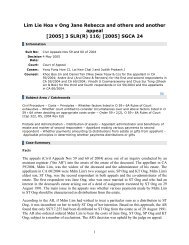
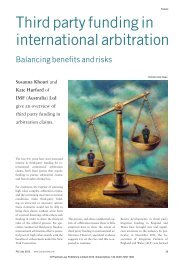
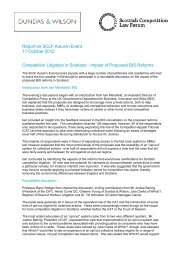
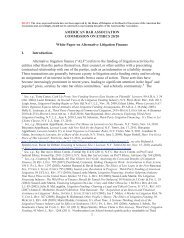

![Hall v Poolman [2009] - Harbour Litigation Funding](https://img.yumpu.com/37488843/1/190x245/hall-v-poolman-2009-harbour-litigation-funding.jpg?quality=85)
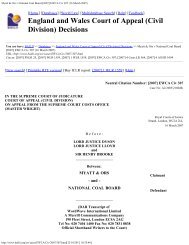

![[2013] SGHC 135 - Singapore Law Watch](https://img.yumpu.com/37488807/1/184x260/2013-sghc-135-singapore-law-watch.jpg?quality=85)
